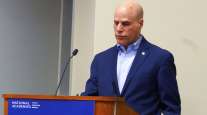Managing Editor
Catenary System Poised for One-Year Test Near California Ports

WASHINGTON — The South Coast Air Quality Management District expects to start a one-year test soon of electrified trucking near two of the nation’s largest ports, the leader of the agency’s division overseeing the program said Jan. 8.
Joseph Impullitti, program supervisor of Science and Technology Advancement at South Coast Air Quality Management District, or SCAQMD, said a catenary system will be used to power trucks, which resembles the process used for trolley cars, in response to federal and state laws to rid pollution and achieve better fuel efficiency.
“Commissioning of the system has begun, which involves applying power to the lines and conducting operational tests,” Impullitti said.
He was speaking to attendees of the annual meeting of the Transportation Research Board during the workshop, “Sustainable Road Freight Transport: Opportunities to Understand, Model and Address the Challenge of Truck Energy and Emissions.” Panelists from Sweden and Germany presented findings from recent demonstrations of electrified longhaul trucking before U.S.-based speakers shared plans for the technology here.
@SouthCoastAQMD's Impullitti tells @TRBofNA urban areas put limits on building catenary infrastructure. Read more in @TransportTopics pic.twitter.com/1gaoWx22yx — Lorrie Grant (@lorriegrant) January 8, 2017
Testing of the Catenary Truck Project runs a mile-long stretch to and from the ports of Los Angeles and neighboring Long Beach as well as railroad centers in an effort to make the area free or nearly free of nitrogen oxide emissions along a part of California’s Highway 710 that is bogged down with truck traffic.
“The ports are an environmental justice area,” Impullitti said.
“It’s a 22-mile stretch from the ports to inland. We’re looking at this technology to have lanes of freeway electrified for 800 to 1,000 trucks from the ports to the rail yards.”
The catenaries are installed in two lanes of Alameda Street in the city of Carson, California, Impullitti said, and demonstrations are set for the second and third quarters.
SCAQMD decided on a catenary system nearly 2 1/2 years ago and contracted for $13.5 million with Munich-based Siemens, which is also testing an electric roadway.
Patrik Akerman of Siemens, who presided over the workshop, said his company will supply the equipment.
“We don’t make the trucks. We make the pantographs on the top that help supply the power,” he said.
The company is working with truck maker Scania on a diesel-hybrid vehicle to test the system in Stockholm. It will cost close to $15 million.
Impullitti said it is too early to finalize a cost in the United States.
As for the vehicles used in the demonstration, SCAQMD is working with Mack Trucks, which is based in Greensboro, North Carolina, and is a unit of Volvo Group, to develop a diesel hybrid. It is also working with Kirkland, Washington-based Kenworth Trucks Co., a division of Paccar Inc., on a compressed natural gas hybrid; and Escondido, California-based Transportation Power Inc. on a CNG hybrid and battery electric truck.
“TransPower vehicles will be used to operate on Alameda Street and conduct further tests of the infrastructure — that will happen in the second quarter,” Impullitti said, adding that that was also when the Mack vehicle was due to arrive.
The agency had to deal with limitations to constructing the infrastructure. Catenary poles are typically underground, but in California snafus occurred. The poles had to be redesigned so that foundation was lodged above ground in order to avoid pipes underground.
There were challenges involving the vehicle, which included how much weight the pantograph would add, navigating bridges and overpasses, and transitioning on and off the power grid, he added.
And there were commercial challenges too, such as regulatory issues like right-of-way, permitting and sale of electric fuel. Then there was the load impact to the electrical grid and finding an owner-operator of the infrastructure as well as timing with trucks.
“It’s the chicken and egg,” Impullitti said, referring to whether to create the infrastructure first or the trucks.




